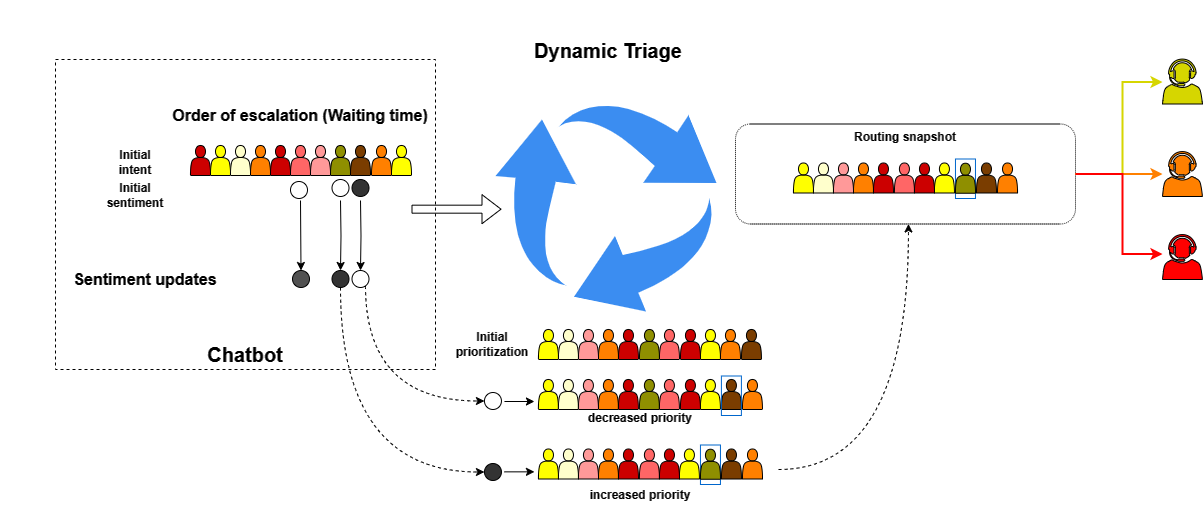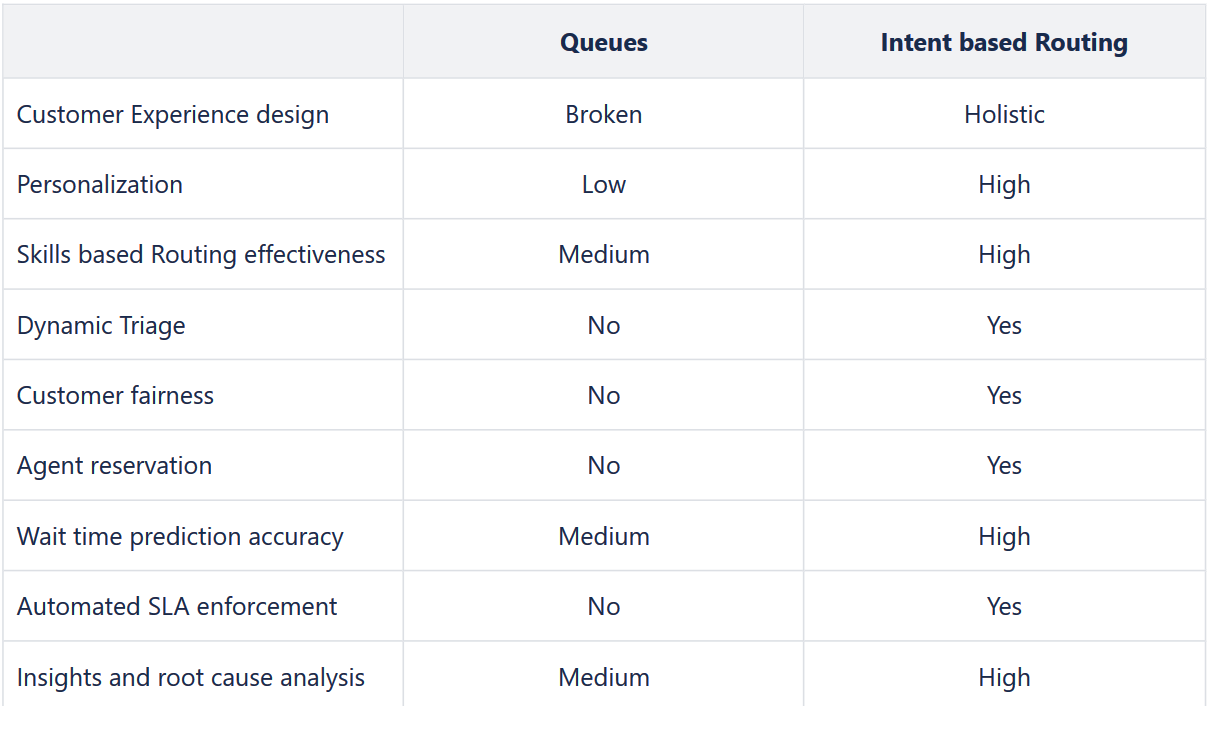Queues are dead! Welcome AI-enabled Intent based Routing!
This article challenges the status quo in the Customer Experience (CX) industry regarding the usage of queues, arguing that they have become obsolete in modern business environments. In an era characterized by rapid technological advancements and evolving customer expectations, the traditional queue system no longer aligns with the need for seamless, efficient service delivery.
As businesses strive to optimize operational efficiency and enhance customer satisfaction, it’s imperative to explore alternatives that minimize wait times, reduce friction, and maximize productivity.
We’ll do a thorough examination of the limitations of queues and propose an innovative solution for a personalized customer experience that works seamlessly, with soon to be ubiquitous, chatbot technology. This holistic approach ensures that customers receive tailored assistance at every touchpoint, while also prioritizing measurable operational efficiency.
What is a Queue in Contact Center software?
A queue in Contact Center software is a prioritized line of interactions awaiting assignment to agents. Typically, the priority within the queue is determined by queuing time, following a First In First Out (FIFO) principle. However, in many cases, priority is based on specific business criteria such as customer profile or contact urgency, with FIFO used as a tiebreaker.
Contact Centers often utilize multiple queues, which may represent different priority tiers, customer support departments or areas of expertise.
Initially, a static triage is conducted to determine the appropriate queue and priority for each interaction. This triage occurs just once, typically based on information gathered during the IVR (Interactive Voice Response) or chatbot interaction.
Interaction routing
Routing entails the assignment of an agent to an interaction based on their capabilities, skills, availability, and capacity.
Agents are typically configured to handle interactions from multiple queues, leading to a scenario where interactions from different queues compete for the same pool of agents.
A simplified routing implementation involving multiple queues typically follows these steps:
• Interactions from all queues are aggregated into a global list.
• Interactions in the global list are ordered based on priority in the original queue.
• Interactions are assigned to available agents in priority order. This process considers factors such as the original queue-agent assignment, agent availability, capacity, and skills.
Queue operations
Supervisors establish performance targets, known as Service Level Agreements (SLAs), for queues. These SLAs typically include metrics like waiting time in queue or customer abandonment rate.
Supervisors continually monitor SLA compliance and enact corrective measures:
• Real-time adjustments involve reallocating agents to enhance throughput on queues experiencing issues.
• Historical analysis is conducted to identify improvement opportunities. This may involve allocating more agents, redesigning queues, enhancing individual agent performance, improving deflection strategies, and other relevant optimizations.
What are the challenges associated with Queues?
Queues have been around since Contact Centers have been invented and are the established strategy for prioritizing interactions and distributing work to agents.
Meanwhile, intelligent chatbots became mainstream and the focus in customer experience approach has shifted. The customer experience starts from the chatbot and extends into the Contact Center.
Queues were relevant in the IVR times, but what about the era of intelligent chatbots? Let’s find out.
Conceptual mismatch
At their core, queues are primarily designed for inward-facing work distribution (Work Queue) rather than as a means to enhance the customer experience.
There’s a clear need for an outward-facing, customer-oriented model. Customer experience design starts from the chatbot and extends into the Contact Center.
A dichotomy arises between the customer-oriented design of chatbots and the inward, task-oriented, nature of queues.
Insufficient personalization
Personalization in customer service ranks high among core Contact Center capabilities according to analyst reports. In the context of interaction routing, the objective is to swiftly pair customers with the most suitable agent by considering factors such as customer profile, interaction history, current needs, sentiment, and urgency.
However, queues primarily serve as a mechanism for ordering interactions, regulating traffic flow, and assigning work to agents.
Due to the coarse-grained nature of queuing, opportunities for personalized service become inherently limited once customers are placed in a queue. Nuanced customer needs are obscured, often resulting in a one-size-fits-all approach.
Triage
Queues-based systems traditionally offer a single opportunity for triage, occurring before interactions enter the queue. This static triage involves selecting the appropriate queue and, sometimes, overriding the default queue priority based on customer profile and custom rules. This model was suitable when IVRs guided customers to the appropriate queue.
However, with the widespread adoption of chatbots, customer expectations have changed. Customers now anticipate more engaging and empathetic interactions. Chatbots equipped with NLP features, including sentiment and urgency detection, have raised the bar for customer engagement. What if the Contact Center could leverage these sentiment and urgency fluctuations during a conversation to execute continuous and dynamic triage?
Dynamic triage is also desirable for internal stimuli, such as SLA monitoring events, allowing proactive corrective measures to be taken.
Using queues, stimuli cannot be dynamically incorporated into the process, limiting the system’s adaptability and responsiveness.
Penalized customers
In the rigid queuing model, low-priority customers often face significant penalization.
Lower-priority interactions are consistently overlooked, while high-priority ones continue to flood in.
But what if there was a prioritization model that balanced customer priority with wait time, ensuring everyone gets a fair chance?
Wait time expectations
Establishing clear customer waiting time expectations is a best practice in Contact Centers.
Some vendors offer predicted wait times, while others provide information on the customer’s position in queue.
However, in many cases, the estimated wait duration may not be accurate. For instance, the position in a queue may not hold much relevance if agents handle work from multiple queues simultaneously. Similarly, predicted wait times computed based on queue throughput statistics may lack precision due to factors like agent churn and agents’ involvement in multiple queues.
Queue design strategy
The design strategy for queues typically revolves around criteria such as priority, business topic or agent department.
However, in complex customer support organizations, achieving desired outcomes can be challenging due to the coarse-grained nature of queues. This often leads to compromises:
Priority Queues:
• The context of customer issues may be diluted.
• Implementing continuous improvement strategies based on irrelevant historical reports can be difficult.
• More suitable for simple organizations with a limited number of defined priorities.
Business Topic Queues:
• Customer profiles are not leveraged effectively.
• Maintaining triage rules to enhance customer affinity can be challenging.
• SLAs based on customer importance cannot be implemented.
• Queues number explosion, where the number of queues becomes unmanageable.
Department Queues:
• The design is rigid due to the limited number and siloed nature of departments in the organization.
Skills based Routing is implemented to alleviate certain challenges, but introduces its own set of challenges:
• It’s unclear which routing strategy takes precedence, queueing or skills-based.
• Monitoring, reporting, and analytics are typically based on queues, limiting the effective application of skills-based routing.
Operational burden
Supervisors monitor queues and intervene manually when SLAs are not met.
Usually, supervisors resort to manually reallocating agents between queues to improve the situation.
This manual process relies heavily on human expertise and is characterized by reduced predictability and repeatability.
A more effective approach is to declaratively configure the desired system behavior when operational quality decreases.
Root cause analysis
In real-time scenarios, supervisors must promptly identify issues and their root causes. However, queues often lack the precision required to take the best corrective actions.
Continuous improvement in customer experience is essential. Supervisors analyze historical data to identify areas for improvement. However, queue-level reporting often fails to provide sufficient insight into actual customer pain points, hindering the implementation of specific improvement measures.
Is there a better alternative to Queues?
Absolutely! The challenges associated with queues can be summarized into these key issues:
• Granularity: Queues lack the granularity needed for customer affinity, personalization, and effective triage.
• Rigidity: Queues imply a fixed interaction ordering after the initial triage, limiting flexibility.
• Worker-oriented: The focus is on emptying queues quickly rather than providing personalized service.
• Inward-oriented: Modern customer experience design begins with the chatbot and extends to the Contact Center. Queues, which worked well with IVR systems collecting simple information, are not suitable for a qualitative end-to-end customer experience.
An alternative approach is needed to address these shortcomings and provide a more dynamic and customer-centric solution.
What does a better alternative look like?
• Identifying fine-grained concepts that capture customer needs and utilizing them to construct an end-to-end personalized customer experience, beginning from the chatbot and extending to routing.
• Ability to perform dynamic triage, allowing for real-time adjustments in priority and routing requirements.
• Implementing a flexible prioritization algorithm that balances the influence of nominal interaction priority and wait time.
• Empowering supervisors with detailed and relevant insights based on actual customer needs, facilitating continuous improvement opportunities.
• Enabling proactive and automated SLA enforcement, granting supervisors the capability to automate system behavior when SLAs are not met, ensuring consistent service quality and predictability.
AI-enabled Intent based Routing
Introducing AI-enabled Intent based Routing!
This cutting-edge approach harnesses real-time customer intent, sentiment, urgency, and historical profiles to seamlessly match interactions with the most suitable agents at the optimal moment.
Intent based
Intent serves as the granular representation of customer needs, answering the fundamental question: Why is the customer engaging with us now?
It offers unparalleled alignment with the customer’s query, facilitating personalized interactions.
Utilizing NLU/NLP chatbot capabilities, AI-driven intents direct the routing process.
Dynamic
Unlike static queueing systems, our router dynamically triages interactions in real-time, responding to external and internal triggers such as changes in intent, sentiment, urgency, and SLA monitoring events. This ensures interactions are prioritized dynamically, enhancing responsiveness and adaptability.
Intelligent
Our algorithm employs a sophisticated approach to prioritize interactions, blending traditional criteria like waiting time and customer profiles with real-time conversation insights such as intent, urgency, and sentiment. By utilizing a flexible formula for priority scoring, our ranking algorithm delivers equitable service across the board, without compromising on efficiency.
Routing
Our router adopts a skills-based routing strategy, aligning agent skills with interaction intent. This strategy maximizes effectiveness, ensuring interactions are routed to agents with the highest affinity, ultimately enhancing the overall customer experience.
Tunable and transparent
Supervisors have access to sophisticated tuning knobs, ensuring routing behavior is tailored to specific business needs. Supervisors act guided by rich real-time and historical insights.
How does it work?
Queues revisited

• Customers initially engage with the Contact Center through IVR scripts.
• Escalated interactions undergo a single triage process and are then sorted into priority queues (static triage).
• The overall priority order dictates that high-priority interactions are prioritized for assignment ahead of others.
• Lower-priority interactions remain in queue, waiting until high-priority interactions have been addressed.
AI-enabled Intent based Routing

• Customers engage with the Contact Center through Chatbot conversations.|
• Escalated interactions undergo dynamic triage, which adapts in response to changes in intent, sentiment, and urgency.
• The prioritization of interactions blends factors such as intent significance, customer sentiment, urgency, and current wait time, ensuring equitable allocation for lower-priority interactions.
• Dynamically triaged interactions are then paired with the most suitable agents, aligning their skillset and proficiency with the specific requirements outlined by the customer’s intent.
The picture provides an example where interactions are dynamically triaged based on customer sentiment updates:
• the initial prioritization considers the customer intent, sentiment, profile and wait time
the sentiment fluctuations lead to reprioritization of interactions
What are the benefits?
Holistic Customer Experience design
The design of the chatbot experience is rooted in intent detection, a foundation that seamlessly extends to the triage and routing processes.
This integrated approach bridges the gap between the chatbot and Contact Center realms, ensuring a cohesive customer journey without the disjointed “throw over the fence” experience. By utilizing consistent intents throughout, customers benefit from a unified and intuitive interaction regardless of the channel they engage with, fostering a seamless and cohesive experience.
Personalization
Prioritization
Unlike queue, intents provide higher precision for classifying interactions.
Interaction priority considers customer intent, sentiment and urgency, providing improved customer affinity in the support process.
Best Agent
Intents offer a detailed method for identifying the specific business case and selecting the most suitable agents to address customer needs.
Aligning intents with the necessary agent skills allows for the best implementation of a Skills-Based Routing strategy. This approach establishes a direct connection between the customer’s actual requirements and the relevant skill set of the agents. Unlike queueing systems, which may involve intermediate steps, this strategy ensures that agent skills remain undiluted and directly applicable to customer needs.
Dynamic triage
Interactions undergo dynamic triage, leading to a prioritization that accurately mirrors the real-time customer experience.
This triage process has the capability to adjust interaction priorities, either elevating or lowering them based on the evolving circumstances. In instances where Service Level Agreements (SLAs) are not met, customers may even be redirected back to the chatbot for further assistance.
Improved KPIs
Fine-grained intents, paired with Skills-based Routing, contribute to decreased handling times (AHT) and enhanced first call resolution (FCR), resulting in heightened customer satisfaction and boosted agent morale.
Customer fairness
As the wait time grows, the ranking algorithm ensures that low-priority interactions have an real opportunity to be assigned to agents.
The supervisors may fine-tune the algorithm parameters to increase or decrease the chance according to the business context.
Opportunity to pair
The most impactful interactions should be handled by the best agents. Without a fixed order queueing system, the router can reserve available agents for potentially more impactful interactions.
Consequently, less impactful interactions may experience a delay. Supervisors possess the tools to adjust and refine this behavior according to specific needs.
Accurate Predictive Wait Time
The routing engine offers a predicted wait time derived from agent-level statistics, enabling the anticipation of the most suitable agent and the timing of pairing.
Operations automation
Real-time routing statistics at the intent level and SLA monitoring enable a transformative shift in Contact Center operations.
Contact Centers currently operate under manual models reminiscent of pre-Cloud Computing practices, where software deployment and management were manually handled in data centers.
In a Cloud native metaphor:
• Throttling and rate limiting: Interactions for low-priority intents are de-prioritized and routed back to the chatbot, as configured by supervisors.
• Elasticity: The system dynamically scales out by adding additional resources when SLAs are not met; on-call agents are automatically mobilized to handle increased workload.
Insights and root cause analysis
Intents serve as valuable tools for conducting effective insights and root cause analysis.
By offering insights at the intent level, supervisors can swiftly identify areas requiring improvement during performance evaluations.
The analytics engine furnishes intent and skills-level statistics pertaining to interaction routing outcomes and customer experiences. This data enables thorough analysis and informed decision-making to enhance overall operations and customer satisfaction.
Comparison table

Closing thoughts
Using queues, stimuli cannot be dynamically incorporated into the process, limiting the system’s adaptability and responsiveness.
AI-enabled Intent based Routing is available in the SentioCX Conversation Orchestration platform. Please visit us at www.sentiocx.com.
